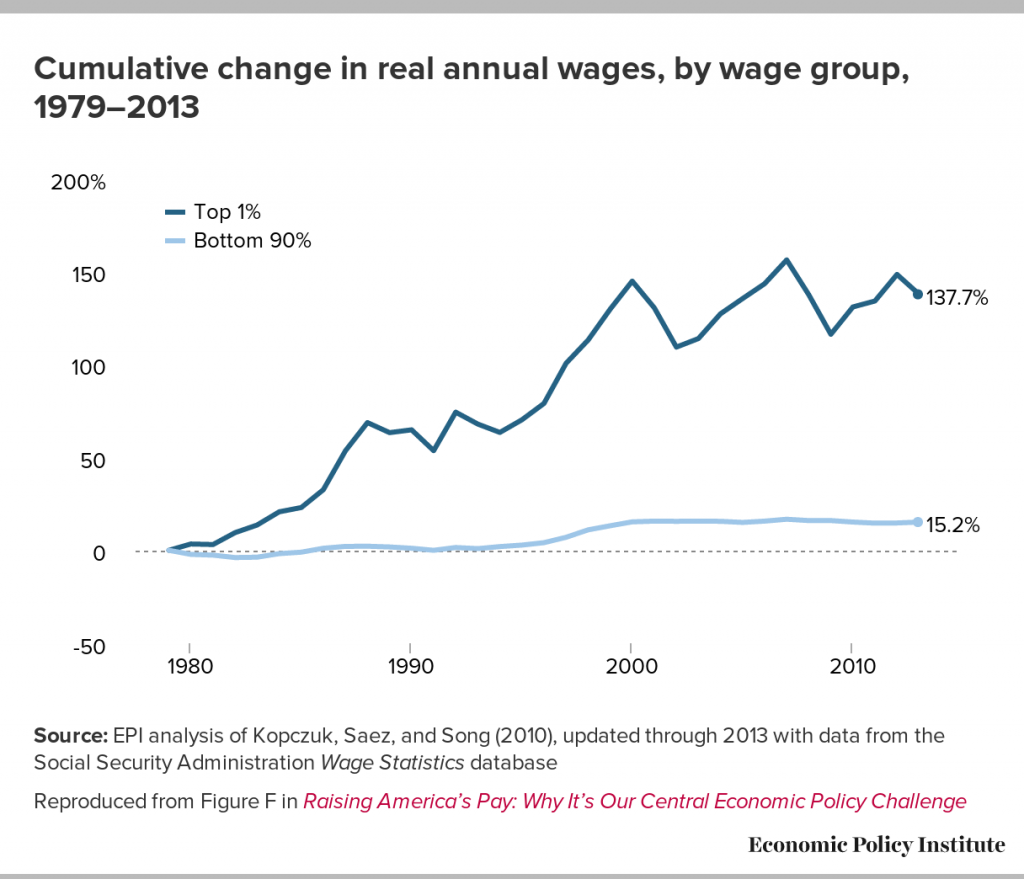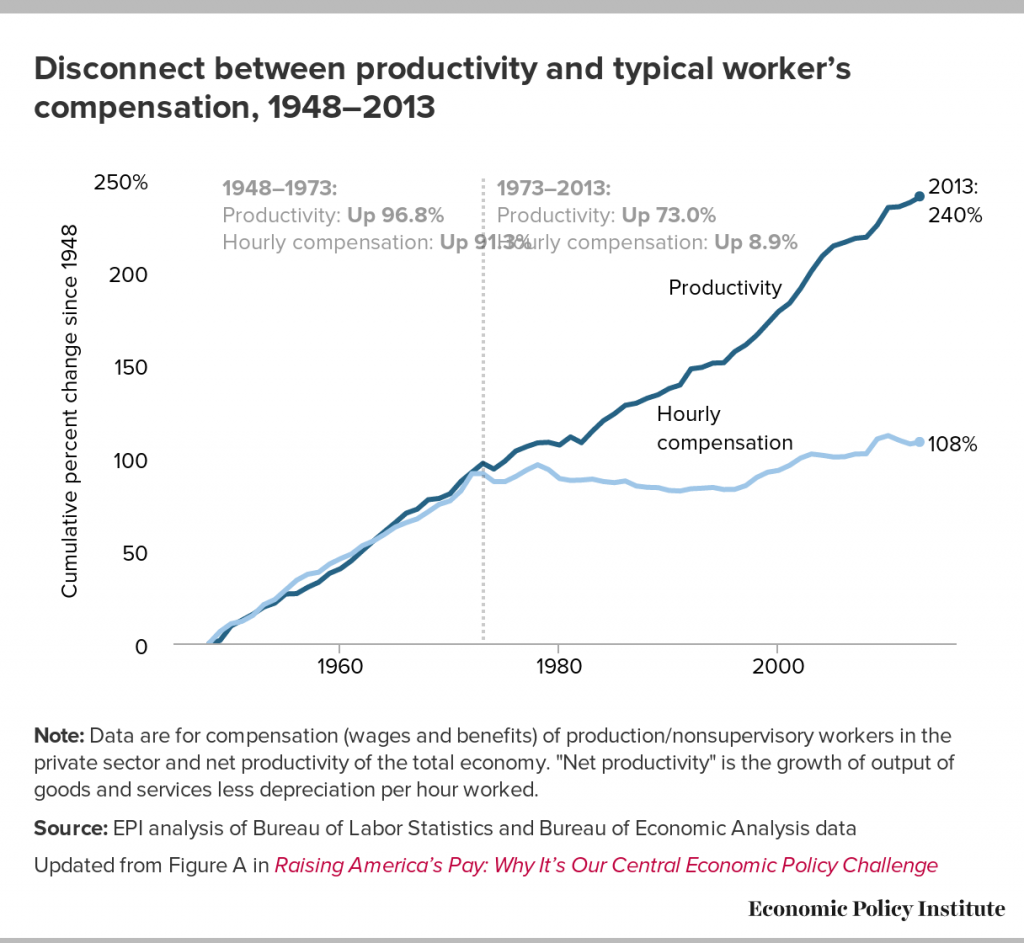Our team recently wrapped up a series of community conversations across Ohio, in an attempt to answer the question: What would it look like if your community was vibrant for everyone?
Depending on the location of the conversations, certain topics were more pertinent than others. However, one topic that came up again and again in all of the conversations was “we need higher paying jobs”.
Ohioans are not alone in this feeling. Although the U.S. has experienced 94 consecutive months of employment gains and has an unemployment rate of 3.7 percent, we’ve also had widespread wage stagnation for the last several decades, which affect both workers across industries and both high school and college graduates.
There is widespread agreement across the political spectrum, as policymakers from both parties have acknowledged that stagnant wages are a critical economic challenge. Luckily, wage stagnation is not inevitable; it is the direct result of several public policy choices. Since wage stagnation was caused by policy, it can be alleviated by policy.
Wage Growth Trends
Throughout the entirety of U.S. history, wages have fluctuated along with the economy. What makes the past forty years different from the rest of history, are the new and inflexible factors contributing to the stagnation of the typical worker’s pay. What we see today is wages have risen for those in the top of the income distribution, but have been stagnant for those in the bottom and middle.
The graph below illustrates the tremendous gap between the 138 percent wage growth enjoyed by the top 1 percent since 1979, and wages for the bottom 90 percent, which grew just 15 percent since then.

You can see from the graph that hourly wages of the vast majority of American workers have either stagnated or declined since 1979. It is important to note that weak wage growth extends even to those with a four-year college degree. The vast majority of college graduates have seen only small wage gains since 2000. Even at the 90th percentile, college graduates’ hourly wages only increased 4.4 percent cumulatively from 2000 to 2013. Entry-level hourly wages fell on average for both female and male college graduates from 2000 to 2013 (8.1 percent among women and 6.7 percent among men).
Despite wages remaining stagnant, we can observe substantial productivity growth over the last forty years – with productivity defined as the value of economic output (or income) generated in an average hour of work in the U.S. economy. Between 1973 and 2016 productivity grew six times as fast as compensation for the typical worker. That gap between economy-wide productivity growth and increases in the typical worker’s pay is the footprint of an economy in which the benefits of growth are largely being captured by those at the top of the income distribution.
You can see this gap presented in the graph below and the pay of a typical worker. Since 1973, there has been productivity growth of 73.0 percent, yet the compensation (wages and benefits) of a typical worker grew far less, just 8.9 percent.

Policies That Lead to Wage Growth
While the trends above have a number of causes, nearly all involve changes in labor market policies and business practices that have led to the reductions in the relative economic leverage, or collective bargaining power, of low- and moderate-wage workers (1, 2, 3). A range of policies—from wage transparency initiatives to modernized labor market standards—could help improve worker’s ability to bargain for higher pay. In addition, policies could be implemented to lift worker mobility and productivity, thereby helping workers to find higher-paying jobs. A number of specific policy actions that could help revitalize wage growth:
- Enhancing pay transparency to put workers and firms on a more level playing field. Without pay transparency, employers have superior knowledge of the distribution of wages relative to workers. This asymmetry of information could actually suppress wage growth since it limits the workers’ ability and inclination to negotiate for a higher pay.
- Modernizing labor market institutions by restoring the real values of the minimum wage as well as protecting union rights. (Next week’s blog will explore in further depth what kind of effect this could have on Ohioans.)
- Updating Overtime Rules – In 1975, 65 percent of salaried U.S. workers were eligible for overtime; today this number has fallen to 11 percent. This is because the salary level beneath which one would be guaranteed overtime pay, has eroded such that only those earning less than $23,660 (a poverty-level wage) are covered by the Fair Labor Standards Act.
- Eliminating non-compete contracts for low-wage workers, while also banning agreements between franchisees that prevent the hiring of each other’s’ employees.
- Better matching postsecondary education and training programs with skills that are highly valued in the labor market, thereby increasing early-career wages.
Discussion
Is employment growth is translating into higher standards of living or higher wages? For whom? How do we sustain growth that benefits a broader share of the population?






The one issue that you did not mention was the low wage stagnation is directly related to the drop in union membership. That is because the Republican Party is against workers trying to unionize. They push right to work laws and make it easier for corporations to fight the unions when they try to organize. Just look at what organization did the most to bring workers into the middle class.